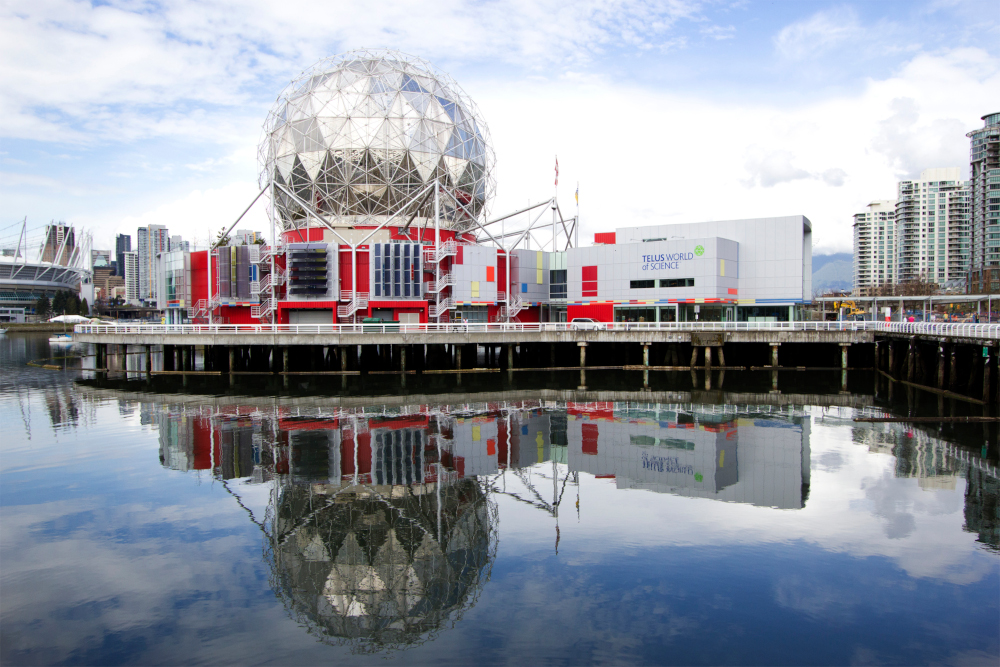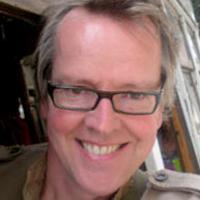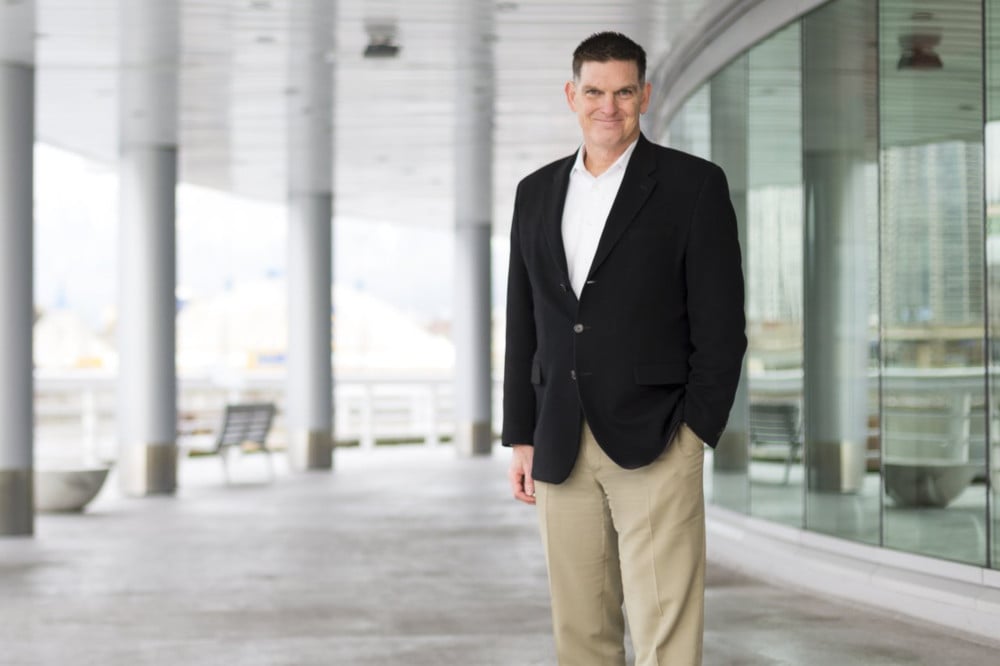Scott Sampson has always been an educator. The fact that he is now operating out of a giant silver sphere covered with blinking lights does not change that. As CEO of Science World, Sampson has administrative and planning responsibilities, running the non-profit organization and sketching out its vision for the future. But education is central to all of it. And Sampson doesn’t just mean teaching school kids neat tricks with static electricity. He has bigger plans.
“I didn’t come here to be a boss,” Sampson says, sitting on a couch in his surprisingly box-shaped office. “I am really passionate about institutions like this being critical vehicles for social change and for helping the community fulfill its most pressing needs. There’s no reason why this place should be viewed first and foremost as a kind of ‘edu-tainment’ place just for kids, as some people see it. We’re looking to modify that perspective.”
The 58-year-old Sampson has a boyish grin familiar to a generation of kids who know him as the host of the PBS show Dinosaur Train, a role he took on years before taking charge of Science World in July 2016. It’s a large operation. With a 2019 budget of $18 million (drawn from entry fees, memberships, retail revenue, contracted services, and donations), a full and part-time staff of 220 plus 550 volunteers, and about 850,000 annual visitors, just keeping the big silver ball rolling along is a major task.
But Dr. Sampson has also concentrated his efforts on charting a new course for the organization. Part of that involves promoting a future powered by STEAM. The acronym stands for Science, Technology, Engineering, Art and Design, and Math. “STEAM has caught on in the past few years,” Sampson says. “It’s all about the future of jobs and the economy.”
“When the kindergarteners of today enter the workforce, two thirds of the jobs that exist today will no longer exist,” he says. “Of those new jobs, 80 per cent of them will require literacy in STEAM. And we’re not training for it right now. So at Science World we have taken it on as our bold purpose to dramatically scale STEAM literacy across B.C. and then through other efforts beyond that.”
Promoting STEAM will not just be restricted to its False Creek location. In addition to in-house exhibits and programs, the organization is reaching out with a grand program called Symbiosis that launched last November. “We are collaborating with government, other non-profits, K through 12, higher education, and with business,” Sampson says. “Seventy-two organizations in all have expressed interest in getting involved. So we’re going to scale it across the province.”
The acronym is often referred to as STEM, but it has been expanded. “There’s been a lot energy around that ‘A’ for a few reasons,” Sampson says. “One, because millennials relate to STEM through art and design, so it’s a way to draw them in, whether it’s through gaming or whatever. The other thing is that if you incorporate art and design, learning actually improves. People interact with science differently if you have that art component.”
“Right now, with most kids in school, if you talk to them about the future, you ask — we all ask this question and it’s one of the dumbest questions you can ask — ‘What do you want to do when you grow up?’ A better question would be: ‘Name all the careers you can think of.’ And they’ll probably come up with a dozen, half of which won’t exist by the time they get out into the job market. So the challenge isn’t to push kids into finding the right career. It’s to open up their minds to the possibilities that are out there. Our job is to turn on the lights so they can see the options, help them find the option that is closest to their passion and abilities, and then give them mentorship to climb the mountain, and turn around and help the next generation.”
That mentorship is key, Sampson believes. “We are actively engaged in training mentors right now, and that includes school teachers — making them more comfortable to teach some of these STEAM concepts — but also including scientists and entrepreneurs and engineers and technologists, all of whom can serve a role inspiring the next generation. One of the things that’s keeping kids of colour, young girls and women out of these fields, is that they don’t see themselves there. But if you can give them role models who look like them and are saying, ‘Are you kidding? I’m in biotechnology and it’s the best thing I’ve ever done,’ then they say, ‘Wow, OK, maybe that’s for me.’” (It’s an approach that seems to be bearing fruit — the STEAM Horizon Award was recently won by Inuk student Tyra Cockney-Goose.)

Sampson’s own education started in Dunbar at Southlands elementary, continued at Point Grey secondary and UBC before he relocated to the University of Toronto. After getting his doctorate in zoology specializing in paleontology, Sampson made his way to the University of Utah where he became chief curator at the museum and a tenured professor. “I had a dream job for a dinosaur paleontologist,” Sampson says. “What every kid would dream of. I had a museum, I had graduate students, I had dinosaurs a few hours away — brand new things found every year.”
But like the legendary Siddhartha who left everything behind to become the Buddha, Sampson was unsatisfied. “I left it because I felt like it wasn’t enough for me,” he recalls. “I needed to address some of the pressing issues in the world that to my mind have to do with a collision of science, nature and society. I decided to leave it, not sure what I was going to do. Ultimately, I was drawn back into the museum realm as an executive. That translated into me coming here.”
A focus on education seems like a natural fit for both Science World and its boss. But it isn’t the only role Sampson wants for his giant buckyball on the shore of False Creek. Cultural events are part of the new agenda — currently Science World is hosting a show of artist Jan de Beer’s paintings using “upcycled” paint.
And Sampson sees Science World becoming a new agora, a public forum or “a safe place for dangerous ideas,” as he puts it. There are plans for an expansion of the facility and an expansion of business hours, all to make Science World a meeting place for discussion and debate.
“We really see ourselves as a place where people could come to discuss the pressing issues of our time,” he says, “whether those ideas are climate change or pipelines or genetically modified foods or artificial intelligence. Where do you go to have conversations about these things? We all live in our little echo bubbles, where we’re getting media from our own little suite of sources. Imagine coming to a completely revitalized dome where you have a digitally immersive experience. We’ll be able to take you anywhere in the universe — to another galaxy, or the Great Bear Rainforest. And then you leave the performance — it might be music, drama, dance, town hall meeting, a lecture, a film festival, anything. And then you head down into another space we’re looking to create which would be a place for a facilitated dialogue. Imagine going there and sitting around with seven strangers talking about whether or not we should be building the Trans Mountain Pipeline. Or whether we should be labelling GMOs. We just don’t have places to do that.”
“I’ve spent most of my professional life in natural history museums, and they are all about the past,” Sampson says. “Now I’m in a science centre. Science centres are typically about the present, they’re about experiential learning — you throw a ball and watch it come down or whatever, and that’s about this moment. What we’re talking about is becoming future-focused, really looking forward and helping people grasp what that future might look like.”
But in a political climate where simple acceptance of scientific fact has become a political issue, any such discussion would seem destined for controversy. “People ask, ‘Are you an advocacy organization?’” Sampson says. “No, we’re not like the Sierra Club or something like that. But we advocate for science, absolutely. If someone comes in and wants to promote pseudo-science, the Earth is flat, or astrology or whatever, we’re going to say no. This is a science organization. And we’re going to tell you why a lot of those things don’t work, and where the current science is. Whether it’s evolution or climate change, we won’t back off from the truth because that is supported by the overwhelming weight of science out there.”
“Organizations like this have critical roles to play in the local community,” Sampson insists. “Just to give one example we went to our local community on the Downtown Eastside and we said, ‘How can we help you?’ And they said, ‘People are dying every day in the opioid crisis. What if [Science World] hosted an event?’ Well, we’ve done two events now. Collaborating with community partners, trying to raise awareness around opioid addiction and the opioid crisis in Vancouver. That’s not something you would traditionally associate with [us] probably. But that’s part of the direction we think we need to go in.”
Is it wise to be optimistic or pessimistic about the future? In answering, Sampson quotes the late Donella Meadows, author of The Limits to Growth and Thinking in Systems. “Whenever she was asked this question,” Sampson says, “she would say something to the effect of ‘I’m not an optimist or a pessimist. I act because it’s what I can do. And in terms of whether there’s enough time to make a difference, there is just enough time. Starting right now.’”
“That’s how I feel about things, too.” ![]()
Read more: Education, Science + Tech
















Tyee Commenting Guidelines
Comments that violate guidelines risk being deleted, and violations may result in a temporary or permanent user ban. Maintain the spirit of good conversation to stay in the discussion.
*Please note The Tyee is not a forum for spreading misinformation about COVID-19, denying its existence or minimizing its risk to public health.
Do:
Do not: